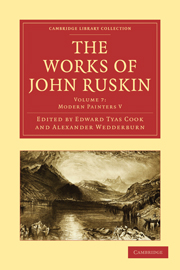Book contents
- Frontmatter
- Contents
- LIST OF ILLUSTRATIONS
- INTRODUCTION TO THIS VOLUME
- BIBLIOGRAPHICAL NOTE
- Modern Painters, Vol. V.
- PREFACE
- PART VI “OF LEAF BEAUTY”
- PART VII “OF CLOUD BEAUTY”
- PART VIII “OF IDEAS OF RELATION:—FIRST, OF INVENTION FORMAL”
- CHAP. I THE LAW OF HELP
- CHAP. II THE TASK OF THE LEAST
- CHAP. III THE RULE OF THE GREATEST
- CHAP. IV THE LAW OF PERFECTNESS
- PART IX “OF IDEAS OF RELATION:—SECOND, OF INVENTION SPIRITUAL”
- EPILOGUE (1888)
- APPENDIX
- Plate section
CHAP. IV - THE LAW OF PERFECTNESS
Published online by Cambridge University Press: 07 September 2011
- Frontmatter
- Contents
- LIST OF ILLUSTRATIONS
- INTRODUCTION TO THIS VOLUME
- BIBLIOGRAPHICAL NOTE
- Modern Painters, Vol. V.
- PREFACE
- PART VI “OF LEAF BEAUTY”
- PART VII “OF CLOUD BEAUTY”
- PART VIII “OF IDEAS OF RELATION:—FIRST, OF INVENTION FORMAL”
- CHAP. I THE LAW OF HELP
- CHAP. II THE TASK OF THE LEAST
- CHAP. III THE RULE OF THE GREATEST
- CHAP. IV THE LAW OF PERFECTNESS
- PART IX “OF IDEAS OF RELATION:—SECOND, OF INVENTION SPIRITUAL”
- EPILOGUE (1888)
- APPENDIX
- Plate section
Summary
§ 1. Among the several characteristics of great treatment which in the last chapter were alluded to without being enlarged upon, one will be found several times named;—reserve.
It is necessary for our present purpose that we should understand this quality more distinctly. I mean by it the power which a great painter exercises over himself in fixing certain limits, either of force, of colour, or of quantity of work;—limits which he will not transgress in any part of his picture, even though here and there a painful sense of incompletion may exist, under the fixed conditions, and might tempt an inferior workman to infringe them. The nature of this reserve we must understand in order that we may also determine the nature of true completion or perfectness, which is the end of composition.
§ 2. For perfectness, properly so called, means harmony. The word signifies literally the doing our work thoroughly. It does not mean carrying it up to any constant and established degree of finish, but carrying the whole of it up to a degree determined upon. In a chalk or pencil sketch by a great master, it will often be found that the deepest shades are feeble tints of pale gray; the outlines nearly invisible, and the forms brought out by a ghostly delicacy of touch, which, on looking close to the paper, will be indistinguishable from its general texture.
- Type
- Chapter
- Information
- The Works of John Ruskin , pp. 236 - 250Publisher: Cambridge University PressPrint publication year: 2010First published in: 1903



